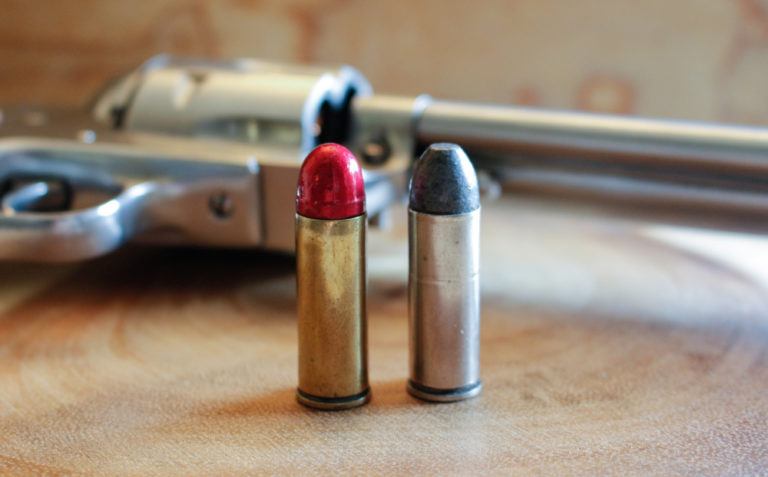
Everyone loves the classic .45 Colt cartridge, and it’s still relevant after almost 150 years.
- The .45 Colt can be loaded down to soft-shooting cowboy loads, or pushed to the limit for heavy hunting applications.
- There are a wide range of bullet styles and weights available for the cartridge, it’s a delight for any reloader.
- An accurate cartridge, the .45 Colt loaded with good 250-grain bullets is no slouch on big game.
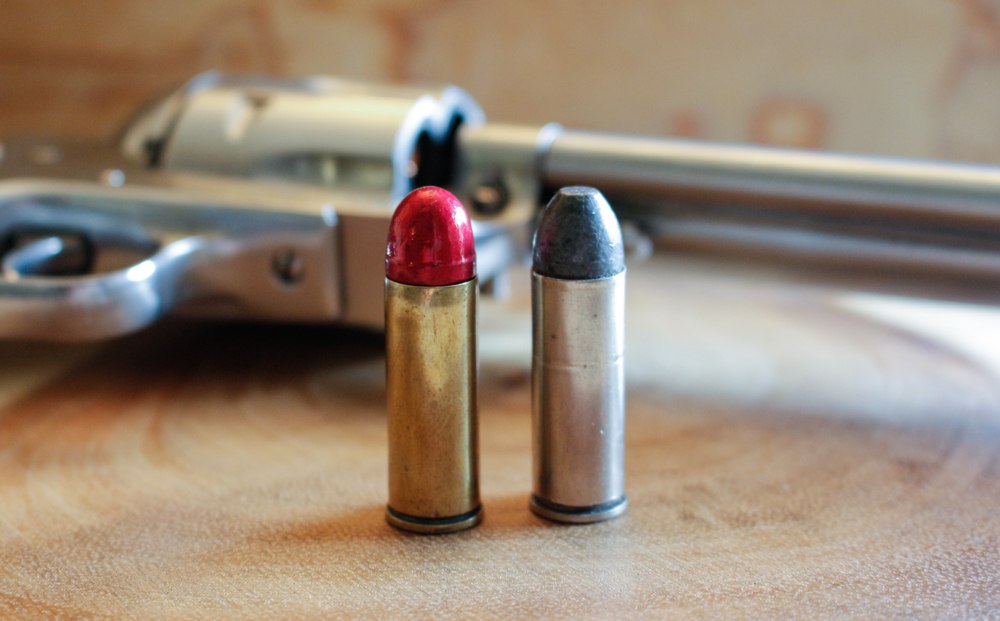
Still Valid After All These Years
The .45 Colt has hung on for years for several reasons. The cartridge has a sound design: a semi-rimmed configuration — that small rim has been criticized through the decades but has never posed a problem in my gun — that has enough case capacity to drive the .452-inch-diameter bullets to respectable velocities in older Single Action Army revolvers and even higher velocities in modern SAA clones, such as the Ruger Blackhawk I love so much.
The .45 Colt can be an excellent cartridge for sending paper banditos to Boot Hill (in cowboy action shooting) and neatly dispatching big game at sensible ranges. In a modern handgun, the .45 Colt can also be very accurate.
My pistol, a Ruger New Model Blackhawk, has adjustable sights that give me an accuracy edge compared to the fixed sights of the SAA clones. I can keep a full cylinder of shots within a 3-inch group at 45 yards, which is more than acceptable to me with my mid-40s eyes.

The Blackhawk has a 7½-inch barrel, generating a bit more velocity, but more important to me, giving me a longer sighting radius. My gun performs better with heavier bullets, and I’m fine with that. Anything heavier than 250 grains provides at least acceptable accuracy, with a few heavy slugs being exceptional.
The variation of bullet weights is another desirable feature of the .45 Colt. It can be loaded to purr like a kitten, and those mild loads are excellent for training a new shooter or for fun plinking days. Yet in my Blackhawk, it can launch slugs weighing up to 360 grains for serious big-game work.
Most ammunition manufacturers still offer the original load of a round-nose or flat-point lead bullet of 250 to 255 grains, with a muzzle velocity of about 800 fps, and that formula works as well as it did in 1873.
Yet folks who hunt big game with the old cartridge can find plenty of factory ammunition options, provided you have a pistol or rifle designed to handle the higher pressures. CorBon offers a 335-grain hardcast lead flat-point in the +P designation, which leaves the muzzle at 1,025 fps and produces 820 foot-pounds of energy.
If that’s not heavy enough for you, DoubleTap ammunition produces a 360-grain hard-cast wide flat-point, which produces 1,200 fps from the muzzle for 1,150 foot-pounds.
In a 16-inch-barreled rifle, that will leave the muzzle at just slower than 1,500 fps for more than 1,700 foot-pounds. That load, in a carbine, is approaching the performance of some lighter .45-70 Gov. loads and would handle about all North American game at close ranges.
There have been many modern upgrades to ammunition for the older wheelguns and lever-action rifles in the past decade, and the .45 Colt is no exception. The most popular is the Hornady LEVERevolution line, which includes the company’s proprietary FTX, or Flex Tip eXpanding, bullet, which uses a flexible polymer tip to allow the use of spitzer bullets in a tubular magazine of a lever-action rifle.
At 225 grains, the Hornady LEVERevolution load will leave the rifle’s muzzle at 900 fps, and provides a much flatter trajectory than the round-nose and flat-point bullets. That configuration adds quite a bit of versatility to traditional lever guns and makes a perfect choice for folks who hunt deer and bear in the thickly forested Northeast, as I do.

On the Defensive
The .45 Colt is not just a hunting tool, though. Although the rifles and pistols are not the traditional choice of a defensive weapon — especially with today’s plethora of Model 1911 and AR-15 style firearms — they will save your bacon just as well now as they did in 1873.
Many newer handgun bullets designed for autoloaders will function well in the .45 Colt revolvers. My gun loves the Hornady XTP in 250 and 300 grains, as well as the Speer Gold Dot 300-grain slug. Both of those have an impeccable reputation as a defensive bullet (they also make fantastic big-game bullets, but that’s not the point), and they shoot very well from most .45 Colts I’ve shot.
On the other end of the spectrum, Cutting Edge Bullets makes a 150-grain Handgun Raptor bullet that can achieve very high velocities (upward of 1,600 fps) in the .45 Colt case. These modern projectiles have mono-metal construction and use a deep hollow-point for rapid expansion. The wall of the hollow-point breaks into small blades for initial impact trauma, and the base of the copper bullet remains at caliber dimension for deep penetration. The bullets make a good choice for home defense — at least for me.
There was a reason I chose that Ruger New Model Blackhawk as my first handgun: Although the pistol was always securely stored, the transfer-bar design of the Ruger revolver seemed to present the most accident-resistant package I could find. In the hands of an educated shooter, the pistol would operate fine, but if the hammer was cocked and the pistol accidentally dropped, the transfer bar would prevent accidental discharge.
The same goes for trigger pull: The trigger must remain depressed throughout the firing sequence for the gun to fire. Any light touch on the trigger would result in a click rather than a fired cartridge. I also appreciated the nostalgia of the .45 Colt over more modern cartridges — namely the .44 Rem. Mag. — so that combination of traditional appearance and modern safety features made for a package I couldn’t resist.
My good buddy Donnie Thorne, better known as Col. Le Frogg, has a brace of Ruger Vaqueros in .45 Colt, with the classic 5½-inch barrels, that are nickel plated and have the actions slicked up. They are possibly the most accurate .45s I’ve shot, and those pistols have a special affinity for my 255-grain lead-bullet handloads, sitting over a mild charge of Alliant’s Unique powder.
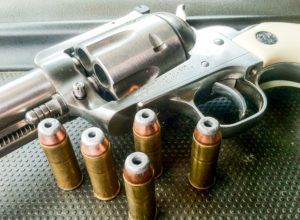
The Vaquero is set up with the same transfer bar as my Blackhawk, so you can carry it confidently with a full cylinder. However, I was trained to always carry a single-action revolver on an empty chamber, and old habits die hard. Le Frogg and I thought long and hard about the cartridge choice for our revolvers, and though we bounced back and forth between classics — .44-40, .44 Mag. and .45 Colt — you know what we ultimately chose.
Compare and Contrast
Let’s address the classic comparison between the .44 Mag. and .45 Colt. On paper, you’d think the .44 Mag. would be the hands-down choice in a hunting revolver. I mean, the .44 Mag. was developed by Elmer Keith (please pause for a moment of silence) and made famous by detective Harry Callahan, so it had the cool factor.
But the .45 Colt has appeared in countless Western movies and was carried across Europe by some dude with a bunch of stars on his uniform named Patton. Famed lawman Bat Masterson ordered a Colt .45 directly from Samuel Colt.
The great controversy around Wyatt Earp’s Buntline Special will continue to rage, but if it existed, it was chambered in .45 Colt (tongue planted firmly in cheek). Needless to say, the .45 Colt’s cool factor rivaled that of the .44 Mag. The fact that Keith (cue angelic music) sang the praises of the .45 Colt, relating tales of mad cows being neatly dispatched and mean broncs having to be put down quickly as they tried to stomp him into the ground, sealed the deal for me.
The .44 Mag. is a fantastic hunting round, fully capable for big game. It can push bullets of similar weight, albeit at a higher pressure and with a bit more recoil. The better sectional density of the .429-inch bullets might penetrate a bit farther, when of the same weight, but a couple of features of the .45 Colt really appealed to me.
First, the .45 Colt can use the many component bullets for the uber-popular .45 ACP, and that’s good. The vast amount of .45-caliber FMJ projectiles manufactured each year make the .45 Colt a wise decision from an economic standpoint as well as availability.
The stout hunting bullets in .452-inch caliber also let the Colt shine as a hunting round. Second, although the .44 Mag. and .45 Colt can produce performance so similar that no animal could tell the difference, the Colt can do so at a much lower pressure.
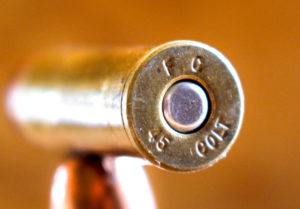
That translates into easier case extraction, longer case life and less recoil, all of which are important to me. So, being a handloader who appreciates the points of the cartridge, I couldn’t wait to start the loading process and find those sweet combinations that make a cartridge shine.
At the Reloading Bench
The .45 Colt isn’t a difficult cartridge to load. You’ll need a good set of reloading dies, with the best roll crimp you can get. As with any straight-wall cartridge for a revolver, you’ll need a good roll crimp on your finished cartridge to keep the bullet in place and prevent it from extending out of the case during recoil.
Especially in the hard-kicking cartridges — such as the full-house .45 Colt loads, as well as the .454 Casull and .44 Mag. — this is very important, as the bullet can pull out of the case and prevent the cylinder from rotating, as well as pose a dangerous situation if the bullet isn’t properly aligned to the bore, which could result in catastrophe or death. I like the Redding Profile Crimp die, as it has produced the most uniform roll crimp I’ve experienced.
I also like the Redding Dual Carbide Sizing dies, as they give the exact dimension I want for proper bullet tension yet don’t overwork the body of the case, extending case life. Carbide dies don’t require lubrication during resizing and won’t allow the case to stick in the die, which is a nice feature when you consider the smaller rim of the Colt case.
The .45 Colt runs on a standard large pistol primer, and I prefer the Federal GM150M for its consistency and reliability. Be sure your primers are seated exactly flush with the case head or slightly recessed to prevent malfunctions and to let the cylinder rotate properly.
Although the .45 Colt has been criticized for having a thin case wall, especially in comparison to the younger magnum pistol cartridges such as the .44 Mag. and .454 Casull, I’ve never had a problem working with the .45 Colt. I try not to excessively flare the case mouth, giving just enough to allow the bullet to seat properly yet not overworking the brass.
In respect to load data, the .45 Colt is really three cartridges in one, and if you intend to reload it, you must be aware of the differences. Look at it this way: There is one set of data for the Colt Single Action Army revolver and its clones, held to a lower velocity and pressure limit. Then, there’s the data for the stronger revolvers and single-shot pistols, which allow the pressures to climb much higher while still performing safely.
Last, there’s the data developed for the lever guns — an entirely different animal.
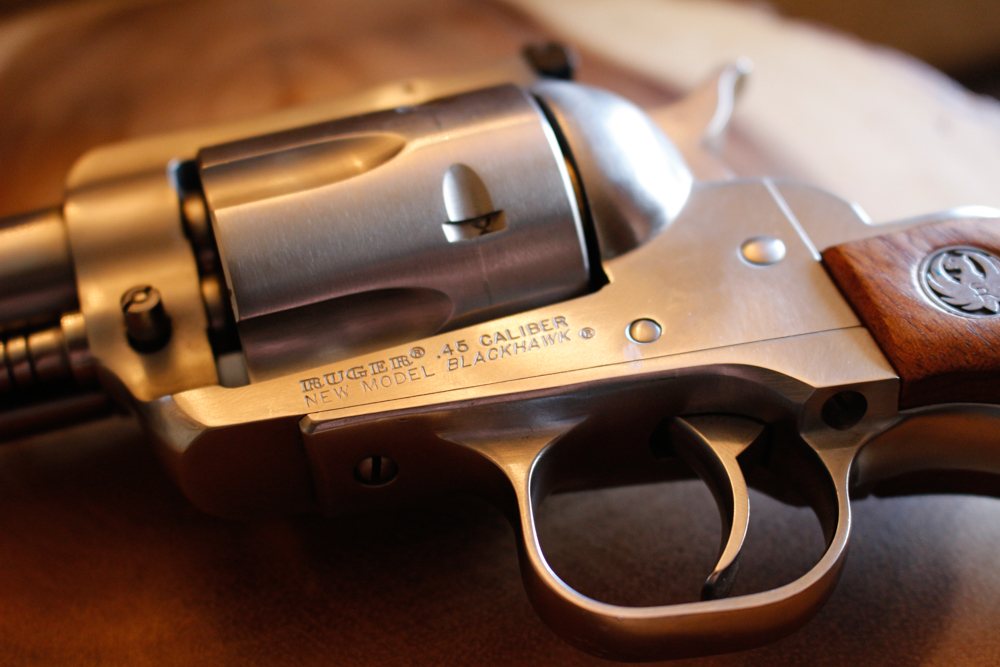
For SAA-class loads, I invariably prefer Alliant’s Unique powder. It burns a bit dirty but has given me fantastic accuracy with many types of cast lead bullets. My favorite combination in this class is the Falcon Bullets Co.’s 230-grain round-nose FalCoated lead bullet over 8.0 grains of Unique. It’s an affordable bullet and plenty accurate for plinking and smaller game.
For my Blackhawk, as a hunting/defense load, I like the Hornady 300-grain XTP-Mag bullet seated over 16.5 grains of Accurate Arms No. 9 powder, at 1,120 fps. This is my favorite load for early-season black bears, because that Hornady bullet will provide consistent expansion and penetration.
The recoil is considerably more than the cowboy loads described earlier, but it’s more than manageable in the 7½-inch-barreled revolver and has proven to be the most accurate of the hunting loads I’ve developed. I limit my distances to 35 to 40 yards, and although Mr. Bruin and I haven’t met when I’ve carried the Blackhawk, I’m confident the venerable cartridge will get the job done.
For lever guns, I like the Hornady FTX bullet. It requires some special treatment from a reloader’s point of view, because the tapered ogive of the FTX bullet demands that the brass case of the .45 Colt be trimmed from 1.285 inch to 1.215 inch so the case mouth aligns with the shank of the projectile rather than sitting upon the ogive. Load that shorter case with 11½ grains of Alliant’s Blue Dot powder, and you’ll have an even 1,100 fps out of your rifle.
Conclusion
The face of cartridge development is ever changing. There’s no denying that. Projectiles continue to be made stronger, cases are modified to produce faster velocities and powders are developed to provide the most uniform results possible.
Many hunters and shooters will flock to embrace the newest technologies, yet others are content with their grandfathers’ cartridges, embracing the nostalgia and romance of yesteryear. I tend to float between the worlds, enjoying the classic combinations that have wonderful reputations but not afraid to put a modern spin on a classic. The .45 Colt epitomizes that idea for me, and I’m happy to have carried one for more than a decade.
Editor’s Note: This excerpt is from Cartridges of the World, 15th Edition.

Next Step: Get your FREE Printable Target Pack
Enhance your shooting precision with our 62 MOA Targets, perfect for rifles and handguns. Crafted in collaboration with Storm Tactical for accuracy and versatility.
Subscribe to the Gun Digest email newsletter and get your downloadable target pack sent straight to your inbox. Stay updated with the latest firearms info in the industry.

![Best Concealed Carry Guns In 2025 [Field Tested] Wilson Combat EDC X9S 1](https://gundigest.com/wp-content/uploads/Wilson-Combat-EDC-X9S-1-324x160.jpg)


![Best 9mm Carbine: Affordable PCCs [Tested] Ruger Carbine Shooting](https://gundigest.com/wp-content/uploads/Ruger-Carbine-Shooting-100x70.jpg)
![Best AR-15: Top Options Available Today [Field Tested] Harrington and Richardson PSA XM177E2 feature](https://gundigest.com/wp-content/uploads/Harrington-and-Richardson-PSA-XM177E2-feature-100x70.jpg)

Also the 45 Webley in the case of WWI when there was still the use of SAA Colts. The Webley case being shorter than the 45 Colt would not fit in the Webley revolver so the 45 Webley was adopted as “standard” until the the 45 ACP came along.
I’ll stick with calling my Redhawk in 45 Colt a 45 Colt. No offence intended
Ref: “Long” Colt. Dan Wesson changed not only the length of the case but the rim diameter as well. Colt: 0.512″ max. The Smith & Wesson round: 0.525″ max. (Figures from “Modern Reloading”, Second Edition, by Richard Lee.)
He did this to ensure positive ejection of the cases in his break-action revolver. It turned out that not all Schofield rounds would fit all Colt revolvers. The Army said “To Heck” with the both of them. They then started manufacturing a cartridge – Schofield case length and Colt rim diameter. In other words, a “short” Colt. Colt never made that cartridge, so their ads just said “45 Colt”. “Long” Colt differentiated the two cartridges in the west where they were being used, side by side, civilian and military.
Somewhere or other I should have some “45 LC” stamped cases. The actual head stamp is “Tombstone”. (Starline brass – special order). We have an FFL 7 ammunition manufacturer in town.
I call my 1st gen.SAA a 45 Colt and my 1911 is a Colt 45 but the rest of my world uses 45 long Colt for the SAA and 45 Colt or Colt 45 for the 1911 so I just roll with it and not get to excited,I have a Uberti 1873 lever action chambered in 45 Colt and its barrel is marked 45 LC so this problem is not going to go away anytime soon.I love the caliber to death no matter what they call it.
Re: “The .45 Colt is sometimes called the .45 Long Colt, indicating the difference between it and the shorter Smith & Wesson Schofield case. The addition of the word Long irritates some shooters, but ammo companies use both names interchangeably.”
Please post a picture of a box of ammo, or a firearm, or a cartridge headstamp, not advertising literature please, that says: “.45 Long Colt”